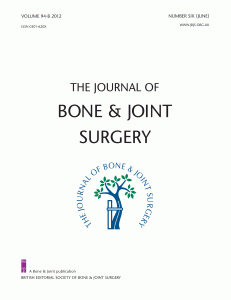Comparison of the Genesis II total knee replacement with oxidised zirconium and cobalt-chromium femoral components in the same patients: a prospective, double-blind, randomised controlled study
Source
Ewha Womans University School of Medicine, The Joint Replacement Center, 911-1, Mokdong, YangChun-Gu, Seoul 158710, South Korea.
- 351 patients (701 knees) with osteoarthritis underwent simultaneous bilateral total knee replacement (TKR), in which each knee was randomized to receive an oxidised zirconium (OxZr) or a cobalt-chrome (CoCr) femoral component.
- After a mean of 7.5 years, there was no significant difference between the two groups for mean weight, size, and shape of the aspirated wear particles.
- The two groups also did not differ in pain, function ratings, range of movement and satisfaction with treatment. Since the OxZr component costs more than the CoCr component, it can be concluded that the CoCr femoral component is most suitable for patients with osteoarthritis undergoing TKR following this mid-term assessment.
Why was this study needed now?
- While previous research has shown that TKR with an OxZr femoral component reduces the rate of polyethylene wear compared to the use of a CoCr component, there has been little consensus with regards to the clinical outcomes of each.
- A past study demonstrated that there was no difference between the two components for the weight, size and shape of polyethylene particles.
- This study aimed to compare the two groups in a larger series in order to confirm the wear rate and clinical outcomes associated with each femoral component.
What was the principal research question?
- Does TKR with an OxZr femoral component result in reduced polyethylene wear and improved clinical outcomes compared to TKR with a CoCr component in patients with osteoarthritis of the knee assessed over a mean of 7.5 years?
Study Criteria
Population: 351 patients (701 knees) with osteoarthritis undergoing simultaneous bilateral total knee replacement
Intervention: OxZr group: (331 patients, or 662 knees, completed the study),TKR with the Genesis II total knee prosthesis (Smith and Nephew, Memphis, Tennessee), with an oxidized zirconium femoral component (n=344 patients/knees; 331 patients/knees completed the entire study)
Comparison:CoCr group: TKR with the Genesis II total knee prosthesis (Smith and Nephew, Memphis, Tennessee) with a cobalt-chrome femoral component (n=344 patients/knees; 331 patients/knees completed the study)
Outcomes: Pain and function were assessed using the Knee Society scores and the Western Ontario and McMaster Universities Osteoarthritis Index score (WOMAC). The active range of motion (ROM) of the knee, post-operative level of activity (using the UCLA score), patient satisfaction (using a Visual Analog Scale), and patient opinions on which knee was best were recorded. Radiographs were used to analyse for osteolysis, patellar tilt, subluxation or dislocation. In patients who were less than 50 years old (120 patients/240 knees), polyethylene wear particles were isolated from synovial fluid of each knee in order to examine the size, shape and weight of the particles.
Methods: RCT: prospective; double blind
Time: Follow up at a mean of 7.5 years (range: 6-8 years)
What were the important findings?
- At follow up, there was no significant difference between the two groups for mean Knee Society scores, WOMAC scores, and ROM (p>0.05)
- All but 15% of the total patients had an UCLA score of 5 or 6, indicating that patients were capable of strenuous farm work (score of 5) or tennis (score of 6)
- The mean satisfaction score for the OxZr group was 8.3 points (SD 1.7) and the mean for the CoCr group was 8.2 (SD 1.8)
- 86% of all the patients did not have a preference for either component, 7% preferred the OxZr component, and 7% preferred the CoCr component
- The two groups did not differ significantly in any of the radiological parameters measured
- The mean weight of the wear particles in the OxZr group (0.0231 SD 0.0052) did not differ significantly from that of the CoCr group (0.0229 SD 0.0058) (p=0.6234); the two groups also did not differ with respect to the size, aspect ratio and roundness of the particles
How will this affect the care of patients?
- Given that OxZr components are more expensive than CoCr while the clinical results of each are equivalent, surgeons should consider using CoCr femoral components as a cost saving measure as it has no apparent impact on patient care at 6-8 years. Further research is needed to confirm the results regarding polyethylene wear over a longer period of time.
What should I remember most?
- Results suggest that there is no difference between the use of an OxZr and a CoCr femoral component in TKR in terms of clinical outcomes and rate of polyethylene wear when assessed over a medium term period of 6-8 years.
Ref:
1. http://www.myorthoevidence.com/2012/?section=15&id=3685&list=2
2. http://www.bjj.boneandjoint.org.uk/content/94-B/9/1221.long
3. http://www.ncbi.nlm.nih.gov/pubmed/22933494


Also read our discussion held almost more than a year ago:
http://orthopaedicprinciples.com/2011/08/oxinium-bearings-fact-or-fiction/